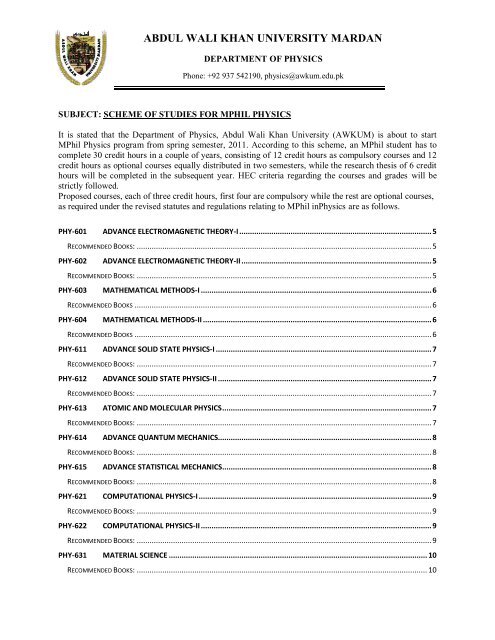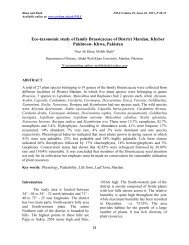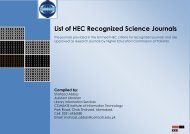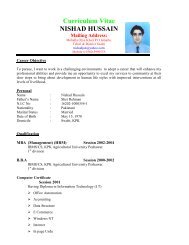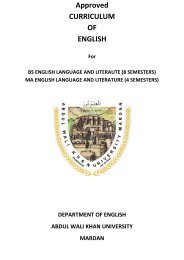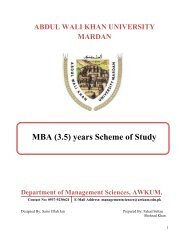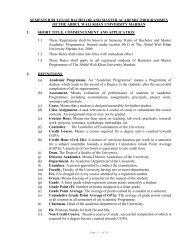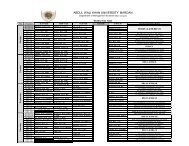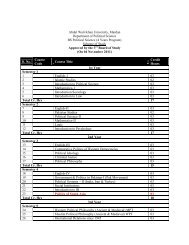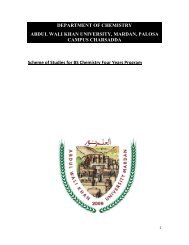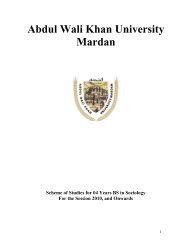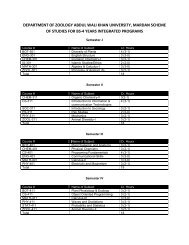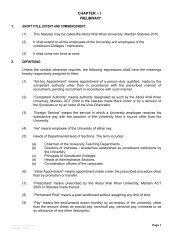ABDUL WALI KHAN UNIVERSITY MARDAN - AWKUM
ABDUL WALI KHAN UNIVERSITY MARDAN - AWKUM
ABDUL WALI KHAN UNIVERSITY MARDAN - AWKUM
You also want an ePaper? Increase the reach of your titles
YUMPU automatically turns print PDFs into web optimized ePapers that Google loves.
<strong>ABDUL</strong> <strong>WALI</strong> <strong>KHAN</strong> <strong>UNIVERSITY</strong> <strong>MARDAN</strong><br />
DEPARTMENT OF PHYSICS<br />
Phone: +92 937 542190, physics@awkum.edu.pk<br />
SUBJECT: SCHEME OF STUDIES FOR MPHIL PHYSICS<br />
It is stated that the Department of Physics, Abdul Wali Khan University (<strong>AWKUM</strong>) is about to start<br />
MPhil Physics program from spring semester, 2011. According to this scheme, an MPhil student has to<br />
complete 30 credit hours in a couple of years, consisting of 12 credit hours as compulsory courses and 12<br />
credit hours as optional courses equally distributed in two semesters, while the research thesis of 6 credit<br />
hours will be completed in the subsequent year. HEC criteria regarding the courses and grades will be<br />
strictly followed.<br />
Proposed courses, each of three credit hours, first four are compulsory while the rest are optional courses,<br />
as required under the revised statutes and regulations relating to MPhil inPhysics are as follows.<br />
PHY-601 ADVANCE ELECTROMAGNETIC THEORY-I .......................................................................................... 5<br />
RECOMMENDED BOOKS: .......................................................................................................................................... 5<br />
PHY-602 ADVANCE ELECTROMAGNETIC THEORY-II ......................................................................................... 5<br />
RECOMMENDED BOOKS: .......................................................................................................................................... 5<br />
PHY-603 MATHEMATICAL METHODS-I ............................................................................................................ 6<br />
RECOMMENDED BOOKS ........................................................................................................................................... 6<br />
PHY-604 MATHEMATICAL METHODS-II ........................................................................................................... 6<br />
RECOMMENDED BOOKS ........................................................................................................................................... 6<br />
PHY-611 ADVANCE SOLID STATE PHYSICS-I ..................................................................................................... 7<br />
RECOMMENDED BOOKS: .......................................................................................................................................... 7<br />
PHY-612 ADVANCE SOLID STATE PHYSICS-II .................................................................................................... 7<br />
RECOMMENDED BOOKS: .......................................................................................................................................... 7<br />
PHY-613 ATOMIC AND MOLECULAR PHYSICS .................................................................................................. 7<br />
RECOMMENDED BOOKS: .......................................................................................................................................... 7<br />
PHY-614 ADVANCE QUANTUM MECHANICS.................................................................................................... 8<br />
RECOMMENDED BOOKS: .......................................................................................................................................... 8<br />
PHY-615 ADVANCE STATISTICAL MECHANICS .................................................................................................. 8<br />
RECOMMENDED BOOKS: .......................................................................................................................................... 8<br />
PHY-621 COMPUTATIONAL PHYSICS-I ............................................................................................................. 9<br />
RECOMMENDED BOOKS: .......................................................................................................................................... 9<br />
PHY-622 COMPUTATIONAL PHYSICS-II ............................................................................................................ 9<br />
RECOMMENDED BOOKS: .......................................................................................................................................... 9<br />
PHY-631 MATERIAL SCIENCE ......................................................................................................................... 10<br />
RECOMMENDED BOOKS: ........................................................................................................................................ 10
PHY-605 PLASMA PHYSICS ............................................................................................................................ 10<br />
RECOMMENDED BOOKS: ........................................................................................................................................ 10<br />
PHY-606 PARTICLE PHYSICS ........................................................................................................................... 10<br />
RECOMMENDED BOOKS: ........................................................................................................................................ 10<br />
PHY-701 INTRODUCTION TO NANOPHYSICS AND NANOTECHNOLOGY ......................................................... 11<br />
RECOMMENDED BOOKS: ........................................................................................................................................ 11<br />
PHY-632 LASERS OPTO-ACOUSTICS SPECTROSCOPY ...................................................................................... 11<br />
RECOMMENDED BOOKS: ........................................................................................................................................ 11<br />
PHY-634 FUNDAMENTALS OF ACOUSTICS ..................................................................................................... 11<br />
RECOMMENDED BOOKS: ........................................................................................................................................ 12<br />
PHY-635 SOLID STATE CHEMISTRY ................................................................................................................ 12<br />
RECOMMENDED BOOKS: ........................................................................................................................................ 12<br />
PHY-636 DIELECTRIC AND OPTICAL PROPERTIES ........................................................................................... 13<br />
RECOMMENDED BOOKS: ........................................................................................................................................ 13<br />
PHY-637 LASERS PHYSICS .............................................................................................................................. 13<br />
RECOMMENDED BOOKS: ........................................................................................................................................ 13<br />
PHY-716 QUANTUM FIELD THEORY ............................................................................................................... 13<br />
RECOMMENDED BOOKS: ........................................................................................................................................ 14<br />
PHY-711 RELATIVISTIC QUANTUM MECHANICS ............................................................................................ 14<br />
RECOMMENDED BOOKS: ........................................................................................................................................ 14<br />
PHY-638 MAGNETIC MATERIALS AND MAGNETIC PROPERTIES ..................................................................... 14<br />
RECOMMENDED BOOKS: ........................................................................................................................................ 14<br />
PHY-721 THE THEORY OF ATOMIC COLLISIONS ............................................................................................. 14<br />
RECOMMENDED BOOKS: ........................................................................................................................................ 15<br />
PHY-722 THE EXPERIMENTAL TECHNIQUES IN ATOMIC COLLISIONS ............................................................. 15<br />
RECOMMENDED BOOKS: ........................................................................................................................................ 15<br />
PHY-731 OPTICAL COMMUNICATION ............................................................................................................ 15<br />
RECOMMENDED BOOKS: ........................................................................................................................................ 15<br />
PHY-732 MICROWAVE COMMUNICATION .................................................................................................... 15<br />
RECOMMENDED BOOKS: ........................................................................................................................................ 16<br />
PHY-734 DIGITAL IMAGE PROCESSING-I ........................................................................................................ 16<br />
RECOMMENDED BOOKS: ........................................................................................................................................ 16<br />
PHY-735 DIGITAL IMAGE PROCESSING-II ....................................................................................................... 16<br />
RECOMMENDED BOOKS: ........................................................................................................................................ 16<br />
PHY-702 MODERN OPTICS AND LASER PHYSICS ............................................................................................ 16<br />
Page 2 of 25
RECOMMENDED BOOKS: ........................................................................................................................................ 16<br />
PHY-741 SIGNAL PROCESSING ....................................................................................................................... 17<br />
RECOMMENDED BOOKS: ........................................................................................................................................ 17<br />
PHY-751 SUPERCONDUCTIVITY ..................................................................................................................... 17<br />
RECOMMENDED BOOKS: ........................................................................................................................................ 17<br />
PHY-752 LOW TEMPERATURE PHYSICS.......................................................................................................... 17<br />
RECOMMENDED BOOKS: ........................................................................................................................................ 17<br />
PHY-713 REACTOR PHYSICS ........................................................................................................................... 18<br />
RECOMMENDED BOOKS: ........................................................................................................................................ 18<br />
PHY-714 QUANTUM ELECTRODYNAMICS ...................................................................................................... 18<br />
RECOMMENDED BOOKS: ........................................................................................................................................ 18<br />
PHY-703 MEDICAL PHYSICS ........................................................................................................................... 18<br />
RECOMMENDED BOOKS: ........................................................................................................................................ 18<br />
PHY-742- SATELLITE ORBIT DETERMINATION AND SIMULATION .................................................................... 18<br />
RECOMMENDED BOOKS: ........................................................................................................................................ 19<br />
PHY-704 PHYSICS OF THIN FILMS .................................................................................................................. 19<br />
RECOMMENDED BOOKS: ........................................................................................................................................ 19<br />
PHY-705 SEMICONDUCTOR DEVICES ............................................................................................................. 19<br />
RECOMMENDED BOOKS: ........................................................................................................................................ 19<br />
PHY-715 ADVANCED COURSES IN RELATIVITY ............................................................................................... 19<br />
RECOMMENDED BOOKS: ........................................................................................................................................ 19<br />
PHY-761 ELECTRON MICROSCOPY-I ............................................................................................................... 20<br />
RECOMMENDED BOOKS: ........................................................................................................................................ 20<br />
PHY-762 ELECTRON MICROSCOPY-II .............................................................................................................. 20<br />
RECOMMENDED BOOKS: ........................................................................................................................................ 20<br />
PHY-765 MAGNETIC RESONANCE IMAGING (MRI) ........................................................................................ 20<br />
RECOMMENDED BOOKS: ........................................................................................................................................ 20<br />
PHY-772 METAL NANOPARTICLES DIFFUSION IN SOLIDS ............................................................................... 21<br />
RECOMMENDED BOOKS: ........................................................................................................................................ 21<br />
PHY-781 LUMINESCENCE OF SOLID MATERIALS ............................................................................................ 21<br />
RECOMMENDED BOOKS: ........................................................................................................................................ 21<br />
PHY-782 INORGANIC SCINTILLATIONS FOR DETECTOR SYSTEMS ................................................................... 21<br />
RECOMMENDED BOOKS: ........................................................................................................................................ 22<br />
PHY-783 RADIATION DETECTION & MEASUREMENT ..................................................................................... 22<br />
RECOMMENDED BOOKS: ........................................................................................................................................ 22<br />
Page 3 of 25
PHY-784 RADIATION PROTECTION ................................................................................................................ 22<br />
RECOMMENDED BOOKS: ........................................................................................................................................ 22<br />
PHY-785 ADVANCE NUCLEAR PHYSICS .......................................................................................................... 23<br />
RECOMMENDED BOOKS: ........................................................................................................................................ 23<br />
PHY-791 RADIATION PHYSICS........................................................................................................................ 23<br />
RECOMMENDED BOOKS: ........................................................................................................................................ 23<br />
PHY-792 PRINCIPLE, METHOD AND APPLICATIONS OF NUCLEAR TRACKS ..................................................... 24<br />
RECOMMENDED BOOKS: ........................................................................................................................................ 24<br />
PHY-793 ENVIRONMENTAL RADIATION DOSIMETRY ..................................................................................... 24<br />
RECOMMENDED BOOKS: ........................................................................................................................................ 24<br />
PHY-794 ENVIRONMENTAL PHYSICS ............................................................................................................. 25<br />
RECOMMENDED BOOKS: ........................................................................................................................................ 25<br />
PHY-795 HEAVY ION PHYSICS ........................................................................................................................ 25<br />
RECOMMENDED BOOKS: ........................................................................................................................................ 25<br />
Page 4 of 25
PHY-601 Advance Electromagnetic Theory-I<br />
Introduction to electrostatics, Coulombs law, electric field, gauss’s law, surface distribution of charges<br />
and dipoles, Poison and Laplace equations, electrostatic potential energy and energy density, boundary<br />
conditions and relations of microscopic to macroscopic fields, the displacement vector, the electric field<br />
in a material medium, polarizability, solution of potential problems, uniqueness theorem, solution by<br />
green functions solutions by inversion, solution by electrical images, two dimensional potential problems<br />
and application, three dimensional potential problems and applications, energy relations and force in the<br />
electrostatic field, field energy in free space, energy density in a dielectric, volume forces in the<br />
electrostatic field in the presence of dielectrics, steady currents and their interactions, the magnetic<br />
interaction of steady line currents, the magnetic scalar and vector potentials.<br />
Recommended Books:<br />
1. Classical Electrodynamics, J. D. Jackson, John Wiley and Sons, New York, 1980.<br />
2. Classical Electricity and Magnetism, Wolfgang K. H. Panofsky and Melba Philips, Addison<br />
Wesley Publishing Co., 1990.<br />
3. Fields and Waves and Waves Electromagnetic, David K. Cheng, Addison Wesley, 1989.<br />
4. Elements of Electrodynamics, Matthew N. O., Sadiku Sunders, Chicago, 1993.<br />
5. Electromagnetic Field Theory, Zahn M. Willey, New York, 1979.<br />
6. Transmission and Propagation of Electromagnetic Waves, Sander, K. F. and Reed Cambridge<br />
University Press England, 1986.<br />
7. Electromagnetic Wave Theory, Kong J. A., John Wiley & Sons New York, 1986.<br />
8. Electromagnetics, Kraus J. D. McGraw-Hill New York, 1992.<br />
PHY-602 Advance Electromagnetic Theory-II<br />
Magnetic materials and boundary value problems, magnetic field intensity, magnetic sources, magnetic<br />
susceptibility uniqueness theorem for the vector potential, Maxwell’s equations for stationary and moving<br />
media, energy relations in quasi-stationary current systems, forces on current systems magnetic volume<br />
force, the wave equation and plane waves, radiation pressure, plane waves in a moving medium, waves in<br />
conducting media, group velocity, the wave equation for the potentials, the radiation field, radiated<br />
energy, the Hertz potential, electric dipole radiation, multiple radiation, radiation from an accelerated<br />
charge, field of an accelerated charge, radiation at low velocity, transformation properties of free radiation<br />
field, electromagnetic mass, radioactive damping of the charged harmonic oscillator, forced vibrations<br />
scattering by an individualfree electron, scattering by a bound electron, absorption of radiation by an<br />
oscillator, scattering from a volume distribution, the dispersion relation, the motion of charged particles in<br />
the electromagnetic fields, world line description, Hamiltonian formulation and transition to three<br />
dimensional formalism, equation for the trajectories of the motion of a particle with magnetic moment in<br />
an electromagnet field.<br />
Recommended Books:<br />
1. Classical Electrodynamics, J. D. Jackson, John Wiley and Sons, New York 1980.<br />
2. Classical Electricity and Magnetism, Wolfgang K. H. Panofsky and Melba Philips, Addison<br />
Wesley Publishing Co. 1990.<br />
3. Fields and Waves and Waves Electromagnetic, David K. Cheng, Addison Wesley 1989.<br />
4. Elements of Electrodynamics, Matthew N. O., Sadiku Sunders, Chicago 1993.<br />
5. Electromagnetic Field Theory, Zahn M. Willey, New York, 1979.<br />
6. Transmission and Propagation of Electromagnetic Waves, Sander, K. F. and Reed Cambridge<br />
University Press England 1986.<br />
7. Electromagnetic Wave Theory, Kong J. A., John Wiley & Sons New York, 1986.<br />
8. Electromagnetics, Kraus J. D. McGraw-Hill New York, 1992.<br />
Page 5 of 25
PHY-603 Mathematical Methods-I<br />
Introduction to the course & Vector algebra, Multiple vector products, Vector derivatives, Vector<br />
integrations, Gauss’s and Stokes theorems and generalizations & potentials, Gauss’s law, Poisson’s<br />
equation, the Dirac deltafunction & Helmholtz theorem, Orthogonal coordinates and derivatives therein,<br />
Cylindrical and spherical coordinates, Tensor analysis & algebra, General tensors,Matrices, determinante<br />
and matrix algebra, Diagonalization of matrices & eigensystem of a matrix, Introduction to group theory,<br />
Orbital angular momenta, The Lorentz group, discrete groups, Differential forms in physics, Infinite<br />
series, their convergence, algebra of series, Function series, elliptic integrals, Bernuolli numbers ,<br />
Divergent series, Infinite products, Complex numbers, regular functions and their integrals, Cauchy’s<br />
Integral, the Laurent series and singularities,Complex mappings,Residues & applications, The Gamma-<br />
Function and derivatives, Approximations and generalizations.<br />
Recommended Books<br />
1. Mathematical Methods for Physics, George Arfken Academics Press New York 1995.<br />
2. Advanced Engineering Mathematics, ErwingKreyszig John Wiley & Sons New York 1993.<br />
3. Applied Analytical Mathematics for Physical Scientists, James T. Cushing John Wiley 1978.<br />
4. Methods of Mathematical Physics 2 Vol, Courant, R and D Hilbert, Wiley Inter-Science, New<br />
York, 1989.<br />
5. Partial Differetial Equations, Epstein B and MalaberMcgraw Hill 1983.<br />
6. Calculus and Analytic Geometry, G.B and R.L. Finney Addison Wesley, 1992.<br />
7. Mathematical Physics, H. K. Dass, & Dr. Rama Verma, S. Chand & Company limited.<br />
PHY-604 Mathematical Methods-II<br />
Partial differential equations; first order (ordinary) differential equations, Separation of variables and<br />
singularities, Series solutions-Frobenius’ method, A Second solution, non-homogeneous equation and<br />
Green’s function, Self-adjoint differential operators and equations, Orthogonalization and completeness<br />
of eigenfunctions, Bessel functions of the first and second kind, Modified and spherical Bessel functions<br />
and asymptotics, Legendre functions, Spherical harmonics and angular momentum, Products and integrals<br />
with spherical harmonics, Hermite and Laguerre functions, Orthogonal polynomials and hypergeometric<br />
functions, Confluent hypergeometric functions, The Fourier transform, Functional properties of the<br />
Fourier transform, Gibbs Phenomenon, discrete Fourier transform, The Fourier integral transform and its<br />
functional properties, Laplace transform, Integral equations, transforms and generating functions,<br />
Neumann series and separable kernels, Hilbert-Schmidt theory, Calculus of variations-many independent<br />
variables, Constrained and Rayleigh-Ritz variation.<br />
Recommended Books<br />
1. Mathematical Methods for Physics, George Arfken Academics Press New York 1995.<br />
2. Advanced Engineering Mathematics, ErwingKreyszig John Wiley & Sons New York 1993.<br />
3. Applied Analytical Mathematics for Physical Scientists, James T. Cushing John Wiley 1978.<br />
4. Methods of Mathematical Physics 2 Vol, Courant, R and D Hilbert, Wiley Inter-Science, New<br />
York, 1989.<br />
5. Partial Differetial Equations, Epstein B and MalaberMcgraw Hill 1983.<br />
6. Calculus and Analytic Geometry, G.B and R.L. Finney Addison Wesley, 1992.<br />
7. Mathematical Physics, H. K. Dass, & Dr. Rama Verma, S. Chand & Company limited.<br />
Page 6 of 25
PHY-611 Advance Solid State Physics-I<br />
The Drude theory of metals, the Summerfield theory of metals, failure of the free electron model, crystal<br />
lattices, the reciprocal lattices, determination of crystal structures by x-ray diffraction, classification of<br />
Bravais lattices and crystal structures, electron levels in a periodic potential, general properties, electrons<br />
in a weak period potential, the tight binding method, other methods for calculating band structure, the<br />
semi-classical model of electron dynamics, the semi classical theory of conduction in metals, measuring<br />
the Fermi surface, band structure of selected metals beyond the relaxation-time approximation, beyond<br />
the independent electron approximation.<br />
Recommended Books:<br />
1. Solid State Physics, Ashcroft and Mermin, CBS Publishing Asia 1976.<br />
2. Solid State Physics 8 th ed., Charles Kittel, John Wiley & Sons 1989.<br />
3. Principles of Solid State Physics, Aimen, John Wiley & Sons, 1988.<br />
4. Solid State Physics, Blakemore, N. B. Sounders Company, 1989.<br />
5. Solid State and Semiconductors Physics, McKalvey, McGraw Hill, 1990.<br />
PHY-612 Advance Solid State Physics-II<br />
Surface effects, classification of solids, cohesive energy, failure of the static lattice model, classical theory<br />
ofthe harmonic crystal, quantum theory of the harmonic crystal, measuring phonon dispersion relations,<br />
anharmonic effects in crystals, phonons in metals, dielectric properties of insulators, homogeneous<br />
semiconductors, inhomogeneous semiconductors, defects in crystals, diamagnetism and paramagnetism,<br />
electron interactions and magnetic structure, magnetic ordering superconductivity.<br />
Recommended Books:<br />
1. Solid State Physics, Ashcroft and Mermin, CBS Publishing ASIA 1976.<br />
2. Solid State Physics 8 th ed., Charles Kittel, John Wiley & Sons 1989.<br />
3. Principles of Solid State Physics, Aimen, John Wiley & Sons, 1988.<br />
4. Solid State Physics, Blakemore, N. B. Sounders Company, 1989.<br />
5. Solid State and Semiconductors Physics, Mckalvey, McGraw Hill, 1990.<br />
PHY-613 Atomic and Molecular Physics<br />
Historical developments in atomic spectra, Classification of series in Hydrogen, Alkali metals and<br />
periodic table, The vector model of atom, multiplets in complex spectra, the Russell Saunders coupling<br />
scheme,Landes theory of multiplet separation and the Zeeman effect, General theory of multiple structure,<br />
Elementary theory of multiplets, Matrix components of the Hamiltonian for the central field problem,<br />
Energy values for simple multiplets, Closed shells and average energies, the average energy of a<br />
configuration, Formulation of multiplet calculations in terms of average energy,Rotation and vibration of<br />
diatomic molecules, The rigid rotator, the harmonic oscillator, the Raman spectrum of the rigid rotator<br />
and the harmonic oscillator, An harmonic oscillator, the symmetric top, Thermal distribution of quantum<br />
states, symmetry properties of the rotational level, The electronic states and electronic transitions,<br />
electronic energy and total energy, Vibrational structure of electronic transitions, rotational structure of<br />
electronic bands.<br />
Recommended Books:<br />
1. Quantum theory of atomic structure, Vol 1, J. C. Slater, Mc-Graw Hill Book New York 1988.<br />
2. Spectra of diatomic molecules, C. Herzberg, 2 nd ed., Van Nostrand Reinhold Co. London 1987.<br />
3. Atomic Physics, J. B. Rajam, S. Chand & Company, 2000.<br />
Page 7 of 25
PHY-614 Advance Quantum Mechanics<br />
Introduction to quantum mechanics, quantum theory and the wave nature of matter, the wave function and<br />
its interpretation, Wave packets and free particle motion, superposition principle, wave packet and<br />
uncertainty relation, Motion of a wave packet, The wave equation, The wave function and the<br />
Schrödinger equation, justification of the wave equation, the interpretation of and the conservation of<br />
probability, expectation values of dynamic variables and operators stationary state solutions, general<br />
solution of the wave equation, The linear harmonic oscillator, Eigen values and Eigen functions, the<br />
double oscillator, the double oscillator Eigen values and Eigen functions, The WKB approximation, the<br />
connection formulas, transmission through barrier, The principle of wave mechanics, coordinates and<br />
momentum representations, Hermitian operators, their Eigen values and Eigen functions, superposition of<br />
Eigen states, simultaneous measurements and computing operators, Central forces and angular<br />
momentum, orbital angular momentum, kinetic energy and angular momentum, the Eigen values problem<br />
for L2 and Lz,The intrinsic angular momentum, spin as a dynamic variable, spin and rotations, spin and<br />
reflections, Perturbation theory, non-degenerate perturbation theory, degenerate perturbation theory,<br />
application to atoms, Variable methods, helium atom, time dependent perturbation theory, Coulomb<br />
excitation, the atom in a radiation field, Scattering, the scattering of a wave packet, Green function in<br />
scattering theory, The Born approximation, phaseshifts, scattering resonances, phase shifts and green s<br />
functions, Coulombs scattering integral equations of scattering theory, properties of scattering states, the<br />
scattering matrix, The Schrodinger Equation in First and Second Quantization, Fermi Systems, Linear<br />
Response and Collective Modes, Bose Systems, Weakly Interacting Bose Gas, Field Theory At finite<br />
Temperature ,physical systems at finite temperature real-time green’s functions and linear response,<br />
Canonical transformations, Nuclear Matter Phonons and Electrons, superconductivity.<br />
Recommended Books:<br />
1. Introduction to Quantum Mechanics,David J.Griffith, Second Ed., 1995.<br />
2. Quantum Mechanics, LugenMerzbacher, John Wiley and Sons, 1997.<br />
3. Quantum Mechanics, L LSchif, McGraw-Hill, 1968.<br />
4. Introduction to Quantum Mechanics, L.Liboff, Addition Wesley, 1992.<br />
PHY-615 Advance Statistical Mechanics<br />
Review of the laws of thermodynamics, First second and third law of thermodynamics and their<br />
applications, The kinetic theory of gases, binary collisions, Boltzmann transport equation, transport<br />
phenomenon, the mean free path, the conservation laws, the zero order approximation, the first Statistical<br />
mechanics, the postulates of classical statistical mechanics, microcanonicalensemble,equipartition<br />
theorem, classical ideal gas, Gibbs paradox, canonical ensemble, energy fluctuation inthe canonical<br />
ensemble grand canonical ensemble, equivalence of the canonical ensemble and thegrand canonical<br />
ensemble, the meaning of the Maxwell construction, Quantum Statistical mechanics, quantum model of<br />
matter, the canonical distributionin quantum statistics,the quantum oscillator, Planks formula for the<br />
equilibrium radiation of a perfectly black body, Heat capacity of solids, heat capacity of a diatomic ideal<br />
gas, Quantum statistic s of a system lf a similar particles,Bose-Einstein and Fermi-Dirac statistics,<br />
Application of Bose-Einstein statistics to the,photongas, application ofFermi-Dirac statistics to the<br />
electron gas in metal, Condensation of an ideal Bose-Einstein gas.<br />
Recommended Books:<br />
1. Statistical Mechanics,Kerson Huang, John Wiley and Sons, New York 1963.<br />
2. Statistical Physics, Y. P. Terletslii, NorthHolland PublishingCo, 1971.<br />
3. Classical Mechanics,Vol 1 &Vol 2, E.A. Desloge, John Wiley, New York 1982.<br />
4. Introduction to Classical Mechanics,A.P. Arya Massachusetts 1990.<br />
5. Classical Mechanics, T.L. Chow John Wiley, New York 1995.<br />
Page 8 of 25
6. Introduction to Classical and Quantum Harmonic Oscillators, S.C. Bloch John Wiley and Sons,<br />
Inc. 1997.<br />
7. Statistical Physics. Volume5, Landau L. D and Lifshits E. M., 1980, Pergamon Press Ltd.<br />
NewYork.<br />
PHY-621 Computational Physics-I<br />
Finite difference, Interpolation formulae, difference quotients, finite differences in two dimensions,<br />
sample applications. LinearAlgebra,Exact methods, iterative methods, Eigen values and Eigen vectors,<br />
sample applications, stochastic,Equidistributed random variants, other distributions, random sequences,<br />
Ordinary differential equations, initial value problems of second order, boundary values problems, partial<br />
differential equations, initial value problems( hyperbolic), initialvalueproblems(parabolic), boundary<br />
value problems, elliptic differential equation, Discrete Fourier transform, Fast Fourier transform, Hough<br />
transform.<br />
Recommended Books:<br />
1. Theory of computation, Walter S Brainerd McGraw Hill 1998.<br />
2. Equations, models and Programs A Mathematical Introduction to computer science, Thomas<br />
J.MyresMcGraw Hill 1999.<br />
3. Mathematical ProgrammingOptimization Models,MikWismewski, Ton AdditsonWesley 1999.<br />
4. Computational physics An introduction vesselyF.J. Plenum Press, New York 1994.<br />
5. Computationalphysics Koonm, S.E.,Benjamin, New York 1985.<br />
6. Computational Statistical Mechanics, Hoover W.G. Elsevier Oxford, UK 1991.<br />
7. Physics programs Boardman, A.D. John Willey andSons, New York 1980.<br />
PHY-622 Computational Physics-II<br />
Simulation and statistical mechanics, Model systems of statistical mechanics, Monte Carlo method,<br />
molecular dynamics simulation, evaluation of simulation experiments, particles and field, stochastic<br />
dynamics, Quantum Mechanical simulation, The diffusion Monte Carlo, path integral Monte Carlo, wave<br />
packet dynamics, density functional molecular dynamics, Hydrodynamics, modeling equationsin<br />
aerodynamics, Some computational example,Simulation of phonon dispersioncurvesand densityof states,<br />
electron energy bands in a one-dimensionalperiodic potential, computer simulation of hot electron<br />
behaviorinsemiconductors, computational study of diffraction by microcrystalline and amorphous bodies.<br />
Computer assisted tutorial in perturbation theory, spherical Bessel functions Legendary function Spherical<br />
Harmonics Annular Momentum Ladder Operators Legend ere/ function of the second kind, special<br />
functions Hermit functions Lauerre functions, Fourier series Applications of Fourier series, Gibbs<br />
Phenomenon Discrete Orthogonalityand Discrete Fourier Transform Convolution, Theorem Laplace<br />
Transform of derivatives Integral Equations, Greens Function one Dimension Two and three Dimensions<br />
Calculus of variations Applications of Euler equation Lagrange Multipliers Rayleigh-Rits Variation<br />
Techniques.<br />
Recommended Books:<br />
1. Theory of computation, Walter S Brainerd McGraw Hill 1998.<br />
2. Equations, models and Programs A Mathematical Introduction to computer science, Thomas<br />
J.MyresMcGraw Hill 1999.<br />
3. Mathematical ProgrammingOptimization Models,MikWismewski, Ton AdditsonWesley 1999.<br />
4. Computational physics: An introduction VesselyF.J. Plenum Press, New York 1994.<br />
5. Computationalphysics Koonm, S.E.,Benjamin, New York 1985.<br />
6. Computational Statistical Mechanics, Hoover W.G. Elsevier Oxford, UK 1991.<br />
7. Physics programs Boardman, A.D. John Willey andSons, New York 1980.<br />
Page 9 of 25
PHY-631 Material Science<br />
Atomic structure and interatomic bonding, the structure of crystalline solids, anisotropy, x-ray diffraction,<br />
determination of crystal structure, imperfections in solids, diffusion, mechanical properties of metals,<br />
dislocations and strengthening mechanism failure, phase diagram, phase transformation in metals, thermal<br />
processing of metal alloys, structures and properties of ceramics and their applications, polymer<br />
structures, characteristics, applications and processing of polymers, composites, corrosion and<br />
degradation of materials, electrical properties, thermal, magnetic and optical properties, materials<br />
selection and design considerations, economics, environmentand societal issues in material science and<br />
engineering.<br />
Recommended Books:<br />
1. Material Science and Engineering,An Introduction, William D. Jr., John Wiley & Sons, 1997.<br />
2. Materials Science 3 rd ed., Anderson, J. C. Leaver, R. D. Van, Nostrand Reinhold UK, 1985.<br />
3. Materials Science and Engineering, William D. Callister, J., John Wiley & Sons, New York 1985.<br />
4. Properties and Selections Iron, Steels and High Performance Alloys, ASM International, Material<br />
Park, OH, 1990.<br />
5. Properties and selection Nonferrous Alloys and Special purpose Materials, ASM International,<br />
Material Park, OH, 1991.<br />
6. Modern Ceramic Engineering: Richerson D. W., 2 nd ed., Marcel Dekker, New York 1992.<br />
PHY-605 Plasma Physics<br />
Introduction, Occurrence of plasma, Concept of temperature, Debye shielding, The plasma parameter,<br />
Criteria for plasma, Applications of plasma physics, Single-particle motion in electromagnetic field,<br />
Uniform and non-uniform E and B fields, Time-variant E and B fields, Fluid description of plasma, Wave<br />
propagation in plasma, Derivation of dispersion relations for simple electrostatic and electromagnetic<br />
modes, Introduction to Controlled Fusion, Basic nuclear fusion reactions, Reaction rates and power<br />
density, radiation losses from plasma, operational conditions.<br />
Recommended Books:<br />
1. F. F. Chen, Introduction to plasma Physics, 2 nd<br />
ed.,Plenum, 1973.<br />
2. N. A. Krall and A.W.Trivelpiece, Principles of Plasma Physics, McGraw Hill, 1973.<br />
3. S. Glasstone and R.H.Lovberg, Controlled Thermonuclear Reactions, D. Van Nestrand1960.<br />
PHY-606 Particle Physics<br />
Ingredients of the Standard Model, Quarks and leptons, Mesons and baryons, Exchange of virtual<br />
particles, Strong, electromagnetic and weak interactions, Relativistic kinematics, Invariant mass,<br />
thresholds and decays, Conservation laws, Angular momentum, Baryon number, lepton number,<br />
Strangeness, Isospin, Parity, charge conjugation and CP, The quark model, Super multiplets, Resonances,<br />
formation, production and decay, Heavy quarks, charm, bottom and top, Experimental evidence for<br />
quarks, Color, confinement and experimental value, Weak interactions, Parity violation, Helicity, CP<br />
violation, K 0 and B 0 systems, The Standard Model and beyond, Quark-lepton generations, Neutrino<br />
oscillations, The Higgs boson, Grand Unified Theories, Supersymmetry.<br />
Recommended Books:<br />
1. Martin, B. R. & Shaw, G. Particle Physics John Wiley & Sons Inc., 1997.<br />
2. Perkins, D.H. Introduction to High Energy Physics Cambridge University Press, 2000.<br />
Page 10 of 25
PHY-701 Introduction to Nanophysics and Nanotechnology<br />
Introduction to nanophysics and nanotechnology, scaling laws and limits to smallness, quantum nature of<br />
nanoworld, nano fabrication, nanoscopy, electron microscopy, atomic force microscopy, scanning<br />
tunneling microscopy, properties and application of semiconductor nanostructures, fabrication of<br />
semiconductor nanowires and quantum dots, electronic and optical properties, optical spectroscopy of<br />
semiconductor nanostructures, carbon nanostructures, nanomagnets.<br />
Recommended Books:<br />
1. Introduction to Nanotechnology, Charles Poole Jr., F. J. Owens, John Wiley & Sons, Inc., 2003.<br />
2. Nanophysics and Nanotechnology: An Introduction to Modern Concepts in Nanoscience, Edward<br />
L. Wolf, Wiley-VCH 2006.<br />
3. Nanotechnology Applications to Telecommunications and Networking, Daniel Minoli, John<br />
Wiley & Sons, Inc., 2006.<br />
4. Nano, The Essentials: Understanding Nanoscience and Nanotechnology, T. Pradeep, Tata<br />
McGraw-Hill Publishing Company Limited, 2007.<br />
5. Carbon Nanotubes: Basic Concepts and Physical Properties, S. Reich, C. Thornsen, J. Maultzsch,<br />
Wiley-VCH Verlag GMBH &Co. KGaA, 2004.<br />
6. Nanoscale Science and Technology, Eds. R. W. Kelsall, I. W. Hamley and M. Geoghegan, John<br />
Wiley & Sons, 2005.<br />
7. The Physics of Semiconductors: An Introduction including Devices and Nanophysics, Marius<br />
Grundmann, Springer-Verlag, Berlin Heidelberg, Germany, 2006.<br />
PHY-632 Lasers Opto-acoustics Spectroscopy<br />
This lecture and laboratory course provides a working understanding of modern optics, lasers, and their<br />
applications. Topics include optical resonators, solid-state, gas, and semiconductor lasers, tunable die<br />
lasers, non-linear optics, and spectroscopy applications. Selected topics, which may vary from year to<br />
year according to interests of the faculty and recent technological developments, will stress practical<br />
instrumentation as well as theory.<br />
Recommended Books:<br />
1. Rosencwaig A. Photoacousticspectroscopy: New-York,etc.:John Willy and Sons, 1980.<br />
2. Gusev V.E., Karabutov. A.A. Laser Optoacoustics. AIP, N.-Y., 1993.<br />
3. Almond D.P. Patel J.Photo thermal science and techniques, London, Chapman and Hall, 1996.<br />
4. Tam A.C. Application of photo acoustic sensing techniques. Rev. Mod. Phys., 1986.<br />
5. Physics Acoustic, Mason W.P., Thurston R.N., Acad. Press 1988.<br />
6. Vargas H., Miranda L.C.M.Photoacoustic and Related photothermal techniques, Phys. Rep.,<br />
1988.<br />
7. Malkin S., Canani O. The use and characteristics of the photoacoustic method in the study of<br />
photosynthesis. Annu. Rev. Plant Physiol. Plant Mol. Biol. 1994.<br />
8. Rogers J.A., Maznev A.A, Matthew J.B., Keith A.N. Optical generation and characterization of<br />
acoustic waves in thin films: Fundamentals and Applications. Annu.Rev. Matter. Sci., 2000.<br />
PHY-634 Fundamentals of Acoustics<br />
The energy and momentum of sound waves, Reflection and refraction of sound waves, Geometrical<br />
acoustics, Propagation of sound in moving medium, Characteristic vibrations, Spherical waves,<br />
Cylindrical waves, The general solution of the wave equation, The lateral wave, The emission of sound,<br />
Scattering of sound, Absorption of sound, Acoustic streaming, Second viscosity, Relaxation process in<br />
gases and liquids, Thermal, structural and chemical relaxation, Some results of the experimental<br />
Page 11 of 25
investigation of acoustical relaxation in liquids, solutions and electrolytes, Acoustical properties of solids<br />
and polymers.<br />
Recommended Books:<br />
1. Theoretical Acoustics, Morse P.M. and Ingard K.V.,McGraw Hill, New York, 1968.<br />
2. Fundamentals of Acoustics, 3 rd Ed., L.E.Kinsler and A.R.Frey.<br />
3. Physical Acoustics, Principles and Methods, Volume I &II, Warren P. Mason, Academic Press,<br />
New York, 1965.<br />
4. Fluid Mechanics, 2 nd Ed., Volume 6, L.D. Landau and E.M. Lifshitz, Pergamon Press.<br />
PHY-635 Solid State Chemistry<br />
Atomic Spectra of Hydrogen, Matter/Energy Interactions Involving Atomic Hydrogen, The Shell Model<br />
(Bohr-Sommerfeld Model) and Multi-electron Atoms, Quantum Numbers, n, l, m, s, De Broglie,<br />
Heisenberg, and Schrödinger, The Aufbau Principle, Pauli Exclusion Principle, and Hund's Rules,<br />
Photoelectron Spectroscopy Average Valence Electron Energy, Octet Stability by Electron Transfer, Ionic<br />
Bonding Properties of Ionic Compounds, Crystal Lattice Energy, Born-Haber Cycle Octet Stability by<br />
Electron Sharing, Covalent Bonding Lewis Structures Hybridization Electronegativity, Partial Charge,<br />
Polar Bonds and Polar Molecules Ionic Character of Covalent Bonds, Pauling's Calculation of<br />
Heteronuclear Bond Energies, LCAO MO, Energy Level Diagrams for H2, He2, Li2 Hybridization,<br />
Double Bonds and Triple Bonds, Paramagnetism and Diamagetism The Shapes of Molecules, Electron<br />
Domain Theory, Secondary Bonding Metallic Bonding, Band Theory of Solids (Heitler and London),<br />
Band Gaps in Metals, Semiconductors, and Insulators, Absorption Edge of a Semiconductor Intrinsic and<br />
Extrinsic Semiconductors, Doping, Compound Semiconductors, Molten Semiconductors Introduction to<br />
the Solid State, the 7 Crystal Systems, the 14 Bravais Lattices Properties of Cubic Crystals, Simple Cubic,<br />
Face-centered Cubic, Body-centered Cubic, Diamond Cubic Crystal Coordinate Systems, Miller Indices<br />
Characterization of Atomic Structure, The Generation of X-rays and Moseley's Law X-ray Spectra,<br />
Bragg's Law X-ray Diffraction of Crystals, Diffractometry, Debye-Scherrer, Laue Crystal symmetry<br />
Defects in Crystals, Point Defects, Line Defects, Interfacial Defects, Voids, Amorphous Solids, Glass<br />
Formation, Inorganic Glasses, Silicates Engineered Glasses, Network Formers, Network Modifiers,<br />
Intermediates Properties of Silicate Glasses Metallic Glass Chemical Kinetics, The Rate Equation, Order<br />
of Reaction, Rate Laws for Zeroth, First, and Second Order Reactions Temperature Dependence of Rate<br />
of Reaction Diffusion, Fick's First Law and Steady-state Diffusion, Dependence of the Diffusion<br />
Coefficient on Temperature and on Atomic Arrangement Fick's Second Law (FSL) and Transient-state<br />
Diffusion, Error Function Solutions to FSL Solutions, Solute, Solvent, Solution, Solubility Rules,<br />
Solubility Product Acids and Bases, Arrhenius, Bronsted-Lowry, and Lewis Definitions, Acid Strength<br />
and pH Organic Chemistry, Basic Concepts, Alkanes, Alkenes, Alkynes, Aromatics, Functional Groups,<br />
Alcohols and Ethers, Aldehydes and Ketones, Esters, Amines Organic Glasses - Polymers, Synthesis by<br />
Addition Polymerization and by Condensation Polymerization Structure-property Relationships in<br />
Polymers, Crystalline Polymers Electrochemistry of Batteries and Fuel Cells Phase Diagrams - Basic<br />
Definitions, Phase, Component, Equilibrium, One-component Phase Diagrams Two-component Phase<br />
Diagrams, Complete Solid Solubility Two-component Phase Diagrams, Limited Solid Solubility Lever<br />
Rule<br />
Recommended Books:<br />
1. Basic Solid State Chemistry, Second Ed., Anthony R. West John Wiley & Sons, New York,<br />
1999.<br />
2. Solid State Chemistry An Introduction, Third Ed., Lesley Smart, Elaine E. Moore CRC Press<br />
Taylor and Francis Group, Boca Raton, London, 2005.<br />
3. Solid State Chemistry and its Applications, Anthony R. West, John Wiley & Sons, New York,<br />
1990.<br />
Page 12 of 25
PHY-636 Dielectric and Optical Properties<br />
Matter polarization and relative permittivity, electronic polarization, covalent solids, various polarization<br />
mechanisms, frequency dependence of relative permittivity, dielectric loss, dielectric strength and<br />
insulation breakdown, capacitor dielectric materials, piezoelectricity, ferroelectricity, pyroelectricity,<br />
refractive index and light absorption, refractive index wavelength behavior, group velocity and group<br />
index, lattice absorption, band-to-band absorption, light scattering in materials, attenuation in optical<br />
fibers, optical anisotropy, uniaxial crystals and Fresnel’s optical indicatrix, birefringence of calcite,<br />
dichroism, optical activity and circular birefringence, electro-optic effects.<br />
Recommended Books:<br />
1. Dielectric Materials and Applications, Arthur R. Von Hippel, Artech House; 1995.<br />
2. Optical Properties of Dielectric Films, Norman N Axelrod, Electrochemical Society, 1968.<br />
3. Dielectric Materials: Introduction, Research and Applications, R. N. P. Choudhary, S. K. Patri,<br />
Nova Science Publishers Inc. 2009.<br />
PHY-637 Lasers Physics<br />
Spontaneous and stimulated emission, absorption, The laser idea, Pumping schemes, Properties of laser<br />
beams, Laser types, Absorption and stimulated emission, Line-Broadening Mechanisms, Nonradiative<br />
decay and energy transfer, Degenerate or strongly coupled levels, Saturation, Fluorscence decay of an<br />
optically dense medium, Energy levels, radiative and nonradiative transitions in molecules, Bulk<br />
semiconductors, Semiconductor Quantum Wells, Quantum wires and quantum dots, Ray and waves<br />
propagation through optical media, Properties of laser beams, Laser beam transformation, propagation,<br />
amplification,vbfrequency conversion, pulse compression and pulse expansion, Solid-State, dye and<br />
semiconductor lasers, Continuous wave laser behavior, Transient laser behavior, Passive optical<br />
resonators, Pumping processes.<br />
Recommended Books:<br />
1. Principles of Lasers, 4 th ed., OrazioSvelto& David C. Hanna Plenum Publishers, 1998.<br />
2. Fundamentals of Quantum Electronics, R.H. Pantell& H. E. Putheff Wiley, New York,1964.<br />
3. Radiation and Noise in Quantum Electronics McGraw-Hill, New York, 1964.<br />
4. Photophysics of Aromatics Molecules, J. B. Birks Wiley-Interscience, New York, 1970.<br />
5. Principles of Optics, 6 th ed., M. Born & E. Wolf Pergamon, Oxford, 1980.<br />
6. Lasers, A. E. Siegman Cambridge University, Oxford, 1986.<br />
PHY-716 Quantum Field Theory<br />
Preliminaries, Classical Lagrangian Dynamics, Lagrangian Field Theory, Global and Local Symmetries,<br />
Noether's Theorem, Canonical Quantization, From Classical to Quantum Mechanics, Quantum Fields and<br />
Causality, Canonical Quantization of Scalar Field Theory, Complex Fields and Anti-Particles, The S-<br />
Matrix in Quantum Field Theory, Time Evolution of Quantum States and the S-Matrix, Feynman<br />
Propagator and Wick's Theorem, Transition Amplitudes and Feynman Rules, Particle Decays and Cross<br />
Sections, Unitarity and the Optical Theorem, Quantum Electrodynamics, Weyl and Dirac Spinors,<br />
Quantization of the Fermion Field, Gauge Symmetry, Quantization of the Electromagnetic Field, the<br />
Photon Propagator and Gauge Fixing, Becchi-Rouet-Stora Transformations, Feynman Rules for Quantum<br />
Electrodynamics,·Renormalization, Renormalizability, Dimensional Regularization, Renormalization of a<br />
Scalar Theory, Displacement Operator Formalism of Renormalization to All Orders, Renormalization<br />
Group Equation, Anomalous magnetic moment and the Lamb shift.<br />
Page 13 of 25
Recommended Books:<br />
1. F. Mandl and G. Shaw, Quantum Field Theory, Wiley, 1992.<br />
2. M. E. Peskin and D. V. Schroeder, Quantum Field Theory, Perseus Books Group, 1995.<br />
3. T. P. Cheng and L. F. Li, Gauge Theory of Elementary Particle Physics, Oxford University Press,<br />
1984.<br />
4. S. Pokorski, Gauge Field Theories, Cambridge University Press, 2000.<br />
PHY-711 Relativistic Quantum Mechanics<br />
Relativistic Quantum Mechanics of Spin ½ particles, Probability conservation in relativistic quantum<br />
mechanics, The Dirac equation, simple solutions, no relativistic approximations, plane waves, covariant<br />
perturbation theory, Natural units and dimensions, S-matrix expansion in the interaction representation,<br />
first-order processes, Mott scattering and hyperons decay, Two-photon annihilation and Compton<br />
scattering, the electron propagator, Mass and charge renormalization radioactive corrections, Greens<br />
functions and field theory (fermions), pictures, Green’s functions, Wicks’s theorem, diagrammatic<br />
analysis of perturbation theory. Fermi systems, HartreeFock approximation, imperfect Fermi gas,<br />
Degenerate electron gas, Linear response and collective modes, General theory of linear response to an<br />
external perturbation, Boss systems, Green’s functions, perturbation theory and feyman rules, Weakly<br />
interacting Boss gas, Finite temperature formalism, Field theory at finite temperature, physical systems at<br />
finite temperature, HartreeFock approximation, imperfect Bose gas near Tc, specific heat of an imperfect<br />
Fermi gas at low temperature, Electron gas, Real-time Green’s functions and linear response.<br />
Recommended Books:<br />
1. Advanced Quantum Mechanics, J. J. Sakurai Addison-Wesley 1980.<br />
2. Quantum Theory of Many-Particle Systems, A L Fetter. J D Walecka, McGraw Hill 1978.<br />
3. Relativistic Quantum Mechanics, J D Bjorken and S D Drell McGraw Hill 1984.<br />
4. Introduction to Quantum Mechanics R H Dicke Addison Wesley 1980.<br />
PHY-638 Magnetic Materials and Magnetic Properties<br />
Electronic, Magnetic, Optical and Ferroelectric Properties of Solids, Emphasis Is on Concepts And<br />
Models Of Phonons And Electronic Energy Bands As Applied To metals, Semiconductors, Magnetic<br />
materials, and insulators, Elementary Quantum And Statistical Mechanics Concepts Are Utilized, The<br />
Mechanical Behavior Of Solids Emphasizing Relationships Between Microstructure And Mechanical<br />
Properties, Elastic, In-elastics, And Plastic Properties Of Materials, Relations between Stress, Strain rate,<br />
and temperature for plastically deformable solids, Application of Dislocation Theory to Strengthening<br />
Mechanisms in Crystalline Solids, The Phenomena Of Creep Fracture and Fatigue and Their Controlling<br />
Mechanisms, The Magnetic Resonance Imaging Technique.<br />
Recommended Books:<br />
1. Introduction to Magnetism and Magnetic Material, David Jiles, Chapman and Hall New York,<br />
1991.<br />
2. Principles of Magnetic particle Testing, Betz, C. E, Magnaflux Corp, 1978.<br />
3. Non Destructive Testing, Helmsman, Edward Arnold Publishers 1987<br />
4. Magnetic methods for non-destructive evaluation, Jiles, D. C, McGraw Hill, 1988.<br />
5. Advances in Permanent Magnetism, Rollin. J, Parker, John Wiley & Sons, In, 1990<br />
PHY-721 The Theory of Atomic Collisions<br />
Collisions, Populations, Energy Distribution, Theoretical Background-Classical and Quantum, The<br />
Experimental Methods Employed in collision Physics, The Elastic Scattering of Electrons in Gases,<br />
Page 14 of 25
Excitation of Atoms and Molecules by Electrons, ionization by Electrons, Positive Ion recombination,<br />
Electron Attachment and Detachment, Photon Emission and Absorption, Elastic Collisions between<br />
Atomic Particles, Ionization and Excitation by Atomic Particles, Charge transfer processes, Collisions of<br />
Excited Atoms and Molecules, Ion-Atom Interchange.<br />
Recommended Books:<br />
1. Physics of atomic collisions, J. B. Hasted, Butter worths London 1984.<br />
2. Atomic and molecular collisions, H. S. W. Massey, Taylor and Franscis, London, 1979.<br />
3. Theory of Atomic collision, Mott N F and Massey, Oxford press 1989.<br />
PHY-722 The Experimental Techniques in Atomic Collisions<br />
The experimental methods employed in collision physics, Sources of atomic and molecular beams,<br />
Sources of atomic hydrogen and similar beams, Source of electron and source of photons in visible and<br />
Ultraviolet, Sources of ions, sources of excited atoms and molecules, Velocity selection of atomic and<br />
molecular beams, velocity selection of electrons, Detection and wavelength measurements of photons,<br />
Velocity and mass selection of ions, Detection and counting of and fast neutrons, Detection of atomic and<br />
molecular beams, Detection of metastable atoms and molecules, Some relevant vacuum problems, The<br />
use of quadruple fields, Experimental methods of charge transfer measurements, ion atom interchange,<br />
Mass spectrometer source experiments, Ion atom interchange experiments at thermal energies.<br />
Recommended Books:<br />
1. Physics of atomic collisions, J. B. Hasted, Butter Worths London 1984.<br />
2. Atomic and molecular collisions, Mott N.F and Massey, Taylor and Francis,London, 1979.<br />
3. Theory of Atomic collisions, Mott N. F. and Massy, Oxford Press 1989.<br />
PHY-731 Optical Communication<br />
Bandpasses for Wavelength Division Multiplexing (WDM) systems. Edge filters for the rejection of<br />
pump radiation from an Erbium Doped Fibre Amplifier. Gain equalization coatings for an Erbium Doped<br />
Fibre Amplifier that function in the transmissive mode. Realities in Mirages, identification of distant<br />
objects by the use of optical images, Effects ofnonhomogenous medium on the images of distant objects<br />
viewed through optical telescope,sodha theory of rays tracing in a medium with a refractive index,<br />
Optical raypropagation under arctic mirage conditions and sodha model. Dynamic Holography and phase<br />
conjugation in photo refractive crystals, Optical fibre sensors.Non Linear dynamic of beams various<br />
spatial profiles and polanzations.<br />
Recommended Books:<br />
1. Laser Optics, Raj KamalR.L. Sawhney Wiley Eastern Limited New Delhi 1992<br />
2. Applied Nonlinear Optics,, F.Zemike and J.Midwinter Wiley Inter-Science New York 1983<br />
3. Problems of Non Linear Optics: S.A. Akhmanov and R.V. Khokhlov Moscow 1978.<br />
PHY-732 Microwave Communication<br />
Benefits of Microwave Communication, Microwave Spectrum, Microwave Applications, Elementary<br />
Fields and Waves, Maxwell’s Equations and Boundary Conditions, Wave Propagation in Perfect<br />
Insulators, Transmission Line Theory, The Impedance Transformation, The Smith Chart, Impedance<br />
Matching and Two-Port Network Analysis, Microwave Transmission Lines, The Open Two- Wire Line,<br />
The Coaxial Line, Rectangular and Circular Waveguides, Coaxial and Strip Line Components, TEM to<br />
TEM Transmissions, Attenuators and Phase Shilters, Waveguide Components, Reciprocal<br />
MultiportJunctions, Microwave Resonators and Filters, Narrowband,Wideband and Microwave Filters.<br />
Page 15 of 25
Recommended Books:<br />
1. Microwave Transmission Line Filters, Malherbe J. A. G. Anech House, Dedham, MA 1979.<br />
2. Stripline Circle Design, Jnr.11. Artech House, Dodham. MA, 1974.<br />
3. Microwave Engineering Passive Circuits, PeterA.Rizzi Prentice-Hall, 1988.<br />
4. Microwave Circuit Theory and Analysis, Ghose, R.N.McGraw-Hill 1993.<br />
5. Micro Wave and Wireless Communication Technology, Joseph Carr 1996.<br />
PHY-734 Digital Image Processing-I<br />
Continuousimage characterization, Mathematical characterization of continuous image, Psychophysical<br />
properties of Vision, Photometry and calorimetry, digital image characterization, image sampling and<br />
reconstruction, Mathematical characterization of Descrete image, Image Quantization, Sampled image<br />
Quality Measure, Discrete Two-DimensionalLinear Processing, Linear Operators, Superposition<br />
Operator, Two Dimensional Unitary Transformations, Two-dimensional Linear Processing Techniques.<br />
Recommended Books:<br />
1. Digital Image Processing, William K Pratt John Willey and Sons 1978.<br />
2. Digital Image Processing,Ganzalez, R.C Wintz Addison- Wesley 1977.<br />
PHY-735 Digital Image Processing-II<br />
Image Enhancement and Restoration, Image Enhancement, Image Restoration Models, Algebraic Spatial<br />
Image Restoration Techniques, Specialized Spatial Image restoration Techniques, Luminance, Color and<br />
Spectral Image Restoration, Image Analysis, ImageFeatureExtraction, Symbolic Image Description,<br />
ImageDetection and Registration, Image UnderstandingSystems, Image Coding, Analog Processing<br />
Image Coding, Digital Point Processing Image Coding,Digital Spatial Processing Image Coding,Image<br />
coding performance analysis.<br />
Recommended Books:<br />
1. Digital Image Processing, William K Pratt John Willey and Sons 1978.<br />
2. Digital Image Processing,Ganzalez, R.C.Wintz Addison-Wesley 1977.<br />
PHY-702 Modern Optics and Laser Physics<br />
This is a lecture and laboratory course offered as a follow-up to PHYSIC 673. Topics include propagation<br />
in anisotropic and non-linear media, birefringence, the physical origin of non-linear polarization, optical<br />
second harmonic generation, parametric oscillation and amplification, electro-optic effects in crystals,<br />
third-order non-linearities, third harmonic generation, phase conjugate optics, four-wave mixing, intensity<br />
dependent transmission, and other selected topics as time permits.<br />
Recommended Books:<br />
1. Rosencwaig A. Photoacousticspectroscopy, John Willey and Sons, New York, 1980.<br />
2. Gusev V.E., Karabutov. A.A. Laser Optoacoustics. AIP, N.-Y., 1993.<br />
3. Almond D.P. Patel J.Photo thermal science and techniques, London, Chapman and Hall, 1996.<br />
450 p.<br />
4. Tam A.C. Application of photo acoustic sensing techniques. Rev. Mod. Phys., 1986,v.58, N2,<br />
pp.381-431.<br />
5. Phys. Acoustic (Ed. Mason W.P., Thurston R.N.), 1988, v.18, Acad. Press., P.168-277.<br />
6. Vargas H., Miranda L.C.M.Photoacoustic and Related photothermal techniques. Phys. Rep.,<br />
1988, v.163, 43.<br />
Page 16 of 25
7. Malkin S., Canani O. The use and characteristics of the photoacoustic method in the study of<br />
thotosynthesis. Annu. Rev. Plant Physiol. Plant Mol. Biol. 1994, 45:493-526.<br />
8. Rogers J.A., Maznev A.A, Matthew J.B., Keith A.N. Optical generation and characterization of<br />
acoustic waves in thin films: Fundamentals and Applications. Annu.Rev. Matter. Sci., 2000, 30:<br />
117-157.<br />
PHY-741 Signal Processing<br />
Characterization Of Signals, Characterization Of Linear Time Invariant Systems, Sampling Of Signals In<br />
Time And Frequency Domain, Algorithm For Convolution And DFT,Multirate Digital signals,<br />
Applications Of Multirate Signals Processing, Linear Prediction And Optimum Linear Filters, Least<br />
Squares Methods For System Modeling And Filter Design, Adaptive Filters, Recursive least Squares<br />
Algorithms For Array Signal Processing, Power Spectrum Estimation, Signal Analysis With Higher<br />
Order Spectra. IFFT and FFT techniques, Time and Space Domain, Frequency domain, Z- transform,<br />
Introduction to Wavelet Technique.<br />
Recommended Books:<br />
1. Advanced Digital Signal Processing, John. G. Proakis, Maxwell Machmillan International, 1999.<br />
2. Signals and system, Alan. V, Oppenheim. Prentice HallUSA, 1995.<br />
3. Fast Algorithms for Digitals Signal Processing, Blahut, R.E, Addison Wesley, 1985.<br />
4. Understanding Digital Signal Processing, Richard G.Lyon, Prentice Hall, 1991.<br />
PHY-751 Superconductivity<br />
Phenomenon of superconductivity, the thermodynamics transition, the MeissnerOchsenfeld effect, the<br />
critical field, the energy gap, Coulomb interaction between electron, the Bose-Einstein gas model, the<br />
quasi-chemical equilibrium theory, the concept of electron pairs as quasi molecules, thermodynamic of<br />
chemical equilibrium, treatment of the ground state, the BCS and Bogoliubov theories at zero<br />
temperature, thermodynamics in the quasi-equilibrium theory, the Meissner effect, persistent currents,<br />
quantumtheory of normal conductivity.<br />
Recommended Books:<br />
1. Theory of Superconductivity, John M. Blatt, Academic Press New York, 1984.<br />
2. Theory of Superconductivity, Lane M. Von, Academic Press New York, 1994.<br />
3. Superconductivity Electronics, Kohara, Prentice Hall, 1987.<br />
4. High Temperature Superconductivity, Ten years after its discovery, K. B. Grag& S. M. Bose,<br />
Narosa Publishing London, 1998.<br />
PHY-752 Low Temperature Physics<br />
Low temperature physics, experimental techniques, low temperature experimental setup, knowledge of<br />
insulation, handling liquid nitrogen and liquid helium gases and lowering of temperature by magnetic<br />
ordering, specific cases of phase transformation studies.<br />
Recommended Books:<br />
1. Low Temperature Physics, Quantum Crystal and Magnetism, K. D. Timmerhaus, McGraw Hill<br />
1999.<br />
2. Low Temperature Physics, Robert E. Uhrig, John Wiley & Sons, New York 1997.<br />
3. Low Temperature Physics, L. P. Birynkov, John Wiley & Sons, New York 1997.<br />
Page 17 of 25
PHY-713 Reactor Physics<br />
Principle concepts in the physics of nuclearsystem, radiation radioactivitydecay and the buildup and<br />
depletion of isotopes in nuclear systems, neutron- nucleus interactions and nuclear cross sections,<br />
transport or radiation usingone group and two-group diffusion theory. Concepts of crititcality and timedependent,<br />
reactors, Neutron-nucleus interactions and nuclear cross section calculations, neutron transport<br />
theory and multi-group diffusion theory, heterogeneous reactor calculations.<br />
Recommended Books:<br />
1. Random Noise Techniques in Nuclear reactor, Robert E.McGraw Hill, New York 1996.<br />
2. Advances in Nuclear physics, Michel Baranger McGraw Hill 1999.<br />
PHY-714 Quantum Electrodynamics<br />
Classical field theory, Canonical quantization of Klein-Gordon, Dirac and Maxwell fields, Interacting<br />
fields, Perturbation theory and Feynman diagram, elementary processes of quantum electrodynamics,<br />
Radiative corrections, Divergences, regularization and re-normalization, Guage field theories and<br />
functional integral formulation, Systematics of re-normalisation, Re-normalisation and symmetric, Renormalisationgroup,Non-Abelian<br />
gauge theories and their quantization, Quantum chromodynamics,<br />
Anomalies, Guage theories with spontaneous symmetry breaking.<br />
Recommended Books:<br />
1. Advance Engineering Electromagnetic, Balanis C. A. Wiley, New York 1989.<br />
2. Classical Electromagnetic, Jackson J. D Griffiths Prentice Hall USA 1989.<br />
3. The theory of Electromagnetic, Jones D. S. Macmillian New York 1984.<br />
PHY-703 Medical Physics<br />
Introduction to Radiotherapy, Nuclear Medicine and Radiology, External beam radiotherapy equipment,<br />
Use of ionizing radiation in radiotherapy, measurement and calculation of absorbed dose, Treatment<br />
planning, Isodose distribution, skin dose and field separation, electron beam therapy, Brachytherapy,<br />
Radiopharmaceuticals, Radioisotope generators, Production of radioisotopes, gamma camera and its<br />
components, SPECT, PET, Production and properties of X-rays, Beam restricting devices, Radiographic<br />
films, types and characteristics, Processing the latent image, Intensifying screen, Radiographic quality,<br />
Mammography, Computed Tomography, magnetic resonance imaging, Ultrasound.<br />
Recommended Books:<br />
1. Physics of Radiation Therapy, Faiz M Khan, Lippincott Williams & Wilkins, Fourth ed. (May 15,<br />
2009)<br />
2. Physics in Medicines & Biology, Paul Davidovits, Academic Press, 3 rd ed., 2007.<br />
3. Physics in Nuclear Medicines, Thames A Sorenson & Michael E Philips, Saunders,3 rd ed., 2003.<br />
4. Instrumentation in Nuclear Medicine, Vol I and II. Ed. Gerald Hine and James Sorenson.<br />
Academic Press Inc, New York, London 1974.<br />
5. Nuclear Medicine. Ed. J.H. Thrall and H. A. Ziessman. 1995. Mosby.<br />
6. Quality Control in Nuclear Medicine. Ed. B.A.Rhodes. The C. V. Mosby Company, Saint<br />
Louis1977.<br />
PHY-742- Satellite Orbit Determination and Simulation<br />
Fundamental Equation of Motion, Two-Body Problem, Astrodynamic Coordinate System, Analytics of<br />
the Two-Body Problem, Determination of an Orbit from Two Positions, Vectors and Time, Determination<br />
Page 18 of 25
of an Orbit From angles only, Mixed Data Determinations, Differential Correction Orbits, Secular<br />
Perturbations, Introduction To Broad Casting Techniques.<br />
Recommended Books:<br />
1. Methods of Orbit Determination, P. R.Escobol, John Wiley &Sons, 1975.<br />
2. Orbit Mechanics for Remote Sensing, Kenneth ID, and Joseph, John Wiley &Sons, 1982.<br />
3. Meteorological Satellite Data, Gray T. I and Mc Cray, McGraw Hill, 1989.<br />
PHY-704 Physics of Thin Films<br />
Methods of preparation of films, methods of examination of films, High – energy electron diffraction,<br />
Growth and structure of films, films structure, mechanical properties of films, mechanical properties of<br />
films, stress in films formed by thermal evaporation, opticalproperties of films, Absorbing films,<br />
magnetic properties offilms, Domains in films, electric properties of films conductive of metal films.<br />
Recommended Books:<br />
1. Thin Film Physics, O.S. Heavens Methuen & Co Ltd 1989.<br />
2. Vacuum Depositionof Thin Films, Holland L. Chapman & Hall 1986.<br />
3. Structure and Properties of thin films, Bean J.W. Wiley New York 1989.<br />
PHY-705 Semiconductor Devices<br />
Semiconductor principles, survey of semiconductor chemistry, semiconductor crystal growth, control of<br />
composition in semiconductor, defect interactions in semiconductors, diffusion processes in Germanium<br />
and Silicon, the chemistry of some compound semiconductors, group-iv semiconductors, properties of<br />
some covalent semiconductors, infrared absorption of semiconductors, recombination and trapping effect<br />
of imperfections on Germanium and Silicon, semiconductor electrodes.<br />
Recommended Books:<br />
1. Semiconductor Physics and Devices,Basic Principles, Donald A. Neamen, McGraw Hill, 2003.<br />
2. Semiconductors, N. B. Hannay, Reinhold Publishing Corporation, 1989.<br />
3. Electron and Holes in Semiconductors, W. Shockley, Princeton, D. Van, 1988.<br />
PHY-715 Advanced Courses in Relativity<br />
Geometrical foundations for space-time theories, Geometrical structures, Affine Geometry, Material<br />
geometry, structure of space-time theories, Absolute space-time theories, Newtonian mechanics, Special<br />
Relativity, Relativistic Particle Dynamics, Relativistic continuum mechanics, Microscopic theory,<br />
Relativistic continuum mechanics, Macroscopic theory, Dynamical space-time theories, foundations of<br />
general relativity, solutions of Einstein equations, experimental tests for general relativity, further<br />
consequences of general relativity, cosmology.<br />
Recommended Books:<br />
1. Principles of relativity physics, Anderson Academic Press New York 1997.<br />
2. Gravitational radiation experiments in relativity, C.de Witt New York 1984.<br />
3. The Classical theory of fields, L. D Landau Addison Wesley 1982.<br />
Page 19 of 25
PHY-761 Electron Microscopy-I<br />
Basic opticsand operation of scanning and transmission electron microscopes.Image formation, modes<br />
ofcontrastand resolution in SEM and TEM.Electron diffraction. Images of perfect crystals and defects in<br />
two-beam diffraction contrast, Analytical microscopy of specimen preparation and insitu microscopy.<br />
Recommended Books:<br />
1. Practicalscanning Electron Microscopy Goldstein, J.I. Yokowitz, H Plenum Press, New York<br />
1977.<br />
2. Electron Microscopy in the study of Materials, Grundy, P.J. and Jones, G A, Edward Annold,<br />
Limited 1976.<br />
3. Transmission Electron Microscopy Thomas, G and Goringe, M. J Jones Wiley & Sons, New<br />
York 1979.<br />
4. Practical Analytical Electron Microscopy in Material Science: WilliamD B Philips Electronics<br />
Instruments 1983.<br />
PHY-762 Electron Microscopy-II<br />
Students will be instructed in the proper use of a scanning and a transmission electron microscope,<br />
allstages from initial alignment of the instrument to presentation of the result will be covered. Three or<br />
four projects will be completed, including obtaining atomic lattice fringeimages and x-ray microanalysis.<br />
Recommended Books:<br />
1. Practicalscanning Electron Microscopy Goldstein, J.I. Yokowitz, H Plenum Press, New York<br />
1977.<br />
2. Electron Microscopy in the study of Materials, Grundy, P.J. and Jones, G A, Edward Annold,<br />
Limited 1976.<br />
3. Transmission Electron Microscopy Thomas, G and Goringe, M. J Jones Wiley & Sons, New<br />
York 1979.<br />
4. Practical Analytical Electron Microscopy in Material Science: WilliamD B Philips Electronics<br />
Instruments 1983.<br />
PHY-765 Magnetic Resonance Imaging (MRI)<br />
A Preview, Nuclear Magnetization, and the Bloch Equation, The Quantum Mechanical Basis of<br />
Precession and Excitation, The Quantum Mechanical Basis of Thermal Equilibrium and Longitudinal<br />
Relaxation, Signal Detection Concepts, Introductory Signal Acquisition Methods, Free Induction Decay,<br />
Spin Echoes, Inversion Recovery and Spectroscopy, One Dimensional Fourier Imaging, k Space and<br />
Gradient Echoes, Multi-Dimensional Fourier Imaging and Slice Excitation, NMR Signal, Continuous and<br />
Discrete Fourier Transforms, Sampling and Aliasing in Image Reconstruction, Filtering and Resolution in<br />
Fourier Transform Image Reconstruction, Projection Reconstruction of Images, Signal, Contrast and<br />
Noise, Fast Imaging in the Steady State, Spin Density, T-1 and T-2 Quantification Methods in MR<br />
Imaging, Introduction to MRI Coils and Magnets.<br />
Recommended Books:<br />
1. Magnetic Resonance Imaging: Physical Principles and Sequence Design, E. Mark, Robert W.<br />
Brown, Michael R. Thompson, Ramesh. V. Willy, 1999.<br />
2. Functional Magnetic Resonance Imaging, Second Ed., S. A. Huettel, A. W. Song, G. McCarthy,<br />
Sinauer Associates Inc., 2008.<br />
3. Handbook of MRI Pulse Sequences, 1 st ed., Bernstein, K. F. King, X. J. Zhoa, Academic press,<br />
2004.<br />
Page 20 of 25
PHY-772 Metal Nanoparticles Diffusion in Solids<br />
Fundamentals of Diffusion, Continuum Theory of Diffusion, Fick’s Laws in Isotropic Media, Fick’s First<br />
Law, Equation of Continuity, Fick’s Second Law, Solutions of the Diffusion Equation, Steady-State<br />
Diffusion, Random Walk Theory and Atomic Jump Process, Atomic JumpProcess, Point Defects in<br />
Crystals, Diffusion Mechanisms, Interstitial Mechanism, Collective Mechanisms, Vacancy Mechanism,<br />
Divacancy Mechanism, Interstitially Mechanism, Interstitial-substitutional Exchange Mechanisms,<br />
Correlation in Solid-State Diffusion, Interstitial Mechanism, Vacancy Mechanism of Self-diffusion,<br />
Vacancy-mediated Solute Diffusion, Dependence of Diffusion on Temperature and Pressure, Activation<br />
Volumes of Self-diffusion, Activation Volumes of Ionic Crystals, Interdiffusion and Kirkendall<br />
Effect,Diffusion and External Driving Forces, Fick’s Equations with Drift, Nernst-Einstein Relation.<br />
Recommended Books:<br />
1. Fundamentals, Methods, Materials, Diffusion-Controlled Processes, Mehrer, Helmut, Springer<br />
Series in Solid-State Sciences, Vol. 155, 2007.<br />
2. Introduction to glass science and technology, J. E. Shelby, Royal Society of Chemistry, 2005.<br />
PHY-781 Luminescence of Solid Materials<br />
Theory of luminescence, Characteristics of Luminescence, Fundamentals of the Quantum theory of<br />
radiation, Theoretical model and mechanism of luminescence, Experimental techniques of luminescence<br />
measurements , Absorption and luminescence spectroscopy, Spectroscopic components, Time-resolved<br />
spectroscopy, Hole-burning, Fluorescence line-narrowing and Photon echo, Quantum efficiency and<br />
nonradiative processes, New developments, Photoluminescence, Classification of photoluminescence in<br />
solids, Band to band luminescence, Wannierexciton luminescence, Characteristics of localized center<br />
luminescence, Extrinsic luminescence of unlocalized type, Extrinsic luminescence of localized type,<br />
Thermoluminescence, Thermoluminescence model, Thermoluminescence mechanism, Methods of<br />
analysis, Applications.<br />
Recommended Books:<br />
1. Luminescence of Solids, D. R. Vij, Plenum Press New York, 1998.<br />
2. Luminescence, From Theory to Applications, R. Ronda (WILEY-VCH Verlag GmbH & Co.<br />
KGaA, Weinheim, Germany, 2008.<br />
3. Luminescence Materials, G. Blasse, B. C. Grabmaier, (Springer-Verlag, 1994.<br />
PHY-782 Inorganic Scintillations for Detector Systems<br />
Basic Principles and Processes, Physical mechanism of scintillation, Creation of electron hole pairs,<br />
Excitation and emission of luminescence centers, Scintillation Materials, Halides, Oxides and Oxides<br />
systems, Interaction of Ionization radiation with scintillators, High energy photons, Charged particles,<br />
Neutral particles, General characteristics of inorganic scintillators, Light yield, Duration of scintillation<br />
pulse, Afterglow, Temperature response, Optical properties, Radiation hardness, Density, Cost<br />
considerations, Conversion of Electronic Excitations in Solids, Charge carriers behavior, Energy losses,<br />
Scintillation yield spectra, Intrinsic Luminescence of Inorganic Scintillators, Excitonic luminescence,<br />
Core to valance transition, Defect Formation by Ionizing Radiation, Mechanism of defect formation,<br />
Efficiency of defect production, Formation time of F-H pairs.<br />
Page 21 of 25
Recommended Books:<br />
1. Physical Process in Inorganic Scintillators, Piotr, A. Rodnyi, CRC Press, Boca Raton New York<br />
1997.<br />
2. Inorganic Scintillators for Detector Systems, Springer-Verlag Berlin Heidelberg 2006.<br />
3. Inorganic Scintillators for Modern and Traditional Applications, M. Globus, B. Grinyov, J. K.<br />
Kim, Institute for single crystals Ukrain-Kharkiv, 2005.<br />
PHY-783 Radiation Detection & Measurement<br />
Particle Detection,Review of atomic and nuclear physics, Natural and Man-made sources of radiations,<br />
Radioactive decays, characteristic and bremsstrahlung X-rays, Interactions of photons with matter,<br />
Interaction of neutrons with matter- Elastic and inelastic scattering and cascade reactions, Interactions of<br />
charged particles with matter- Elastic, inelastic, Semi-classical derivation of Bethe's formula of stopping<br />
power, Energy loss for electrons and heavy ions, Ionization, Recombination effects, Principle and<br />
operating characteristics of ionization chambers, Proportional and Geiger Mueller Counters, Scintillation<br />
mechanism in organic and inorganic detectors, Principle and operating characteristics of various types of<br />
scintillation detectors, Gamma Spectroscopy, Uses and operational characteristics of surface-barrier<br />
semiconductor detectors and Lithium-drifted &Hyper-pure Germanium (HPGe) detectors, Slow and fast<br />
neutron detection methods and spectroscopy, Thermoluminiscence (TL) dosimetery, Nuclear Electronics,<br />
Nature of information provided by the detectors, pulse shapes and times, preamplifiers and their<br />
functions, Main amplifiers, Pulse-shaping networks, integration and differentiation circuits, pole zero<br />
cancellation, Signal to noise ratio, Coincidence units, Analogue to digital converter (ADC), Multi-channel<br />
analyzers.<br />
Recommended Books:<br />
1. Radiation Detection and Measurements, 3rd Ed., Glen F Knoll, John Wiley & Sons, Inc. 1999.<br />
2. Nuclear Radiation Detection, 2 nd Ed., W. J. Price, McGraw Hill,1964.<br />
3. Atoms, Radiation, and Radiation Protection, James E. Turner, John Wiley & Sons, Inc. 1995.<br />
PHY-784 Radiation Protection<br />
Philosophy of radiation protection, quantities and units used in radiation protection, deterministic and<br />
stochastic effects, External and internal exposures and their protection, Inverse square law of external<br />
protection, Dose limits, Annual limits of intake, Recommendations of International Commission on<br />
Radiological Protection, Radiation safety criteria, TL dosimeters, film badges, neutron dosimters, albedo<br />
dosimeters, internal dose assessment procedures, ICRP recommendations. Surface contaminationevaluation<br />
and control, Criticality, Four Factor Formula, Contamination and decontamination, Radiation<br />
Shielding, Gamma & X-Ray shielding calculations, Gamma-ray attenuation and build-up factors, Beta<br />
particle shielding, Neutron moderation and shielding, shielding calculations for X-Ray machines.<br />
Recommended Books:<br />
1. Radiation Detection and Measurements, 3rd Ed., Glen F Knoll, John Wiley & Sons, Inc. 1999.<br />
2. Introduction to Health Physics, 3 rd Ed.Herman Cember, McGraw Hill, 1996.<br />
3. Radiation Dosimetry, Instrumentation and Methods, 2 nd Ed., Gad Shani, CRC Press, 2000.<br />
4. An Introduction to radiation Protection, 4 th Ed., A. Martin and S.A. Herbison, Hodder Arnold,<br />
1998.<br />
Page 22 of 25
PHY-785 Advance Nuclear Physics<br />
General Properties of Nuclei (mass, size, spin etc.,), The sizes ofprotonand neutron, Nuclear Forces,<br />
Nuclear Models (Fermi Gas, Liquid Drop, Shell, Collective), Theories of Alpha, Beta and Gamma Decay,<br />
Nuclear Reactions and kinematics, Cross sections: Classical and Quantum Mechanical derivation,<br />
Nuclear and Nucleon Form Factors,Nuclear Fission and its Mechanism, Bohr and Wheeler theory of<br />
Nuclear Fission, Chain fission reaction, Nuclear reactor, Reproduction of nuclear fuel, Nuclear Fusion<br />
and Thermonuclear explosion, Evolution ofthe Universe, Nucleosynthesisbeforformation of stars,<br />
Elementary Particles, Cosmic Rays*, Some Famous Experiments (Past, Current and Future)<br />
Recommended Books:<br />
1. Introductory Nuclear Physics, Kenneth S Krane, John Wiley & Sons, 1988<br />
2. An Introduction to Nuclear Physics, Second Ed., W. N. Cottingham and D. A. Greenwood,<br />
Cambridge university Press, 2004<br />
3. Nuclei and Particles, Second Ed., E. Segre, W. A. Benjamin, 1977<br />
4. Subatomic Physics: Nuclei and Particles (Volume 1 & 2), L. Valentin, Paris, France: Hermann,<br />
Amsterdam, Netherlands: North-Holland, 1981<br />
5. Concepts of Nuclear Physics, B. L. Cohen, McGraw-Hill, New York, 1971<br />
6. Fundamentals of Physics, N.A. Jelley, Cambridge University Press, 1990<br />
PHY-791 Radiation Physics<br />
Review of atomic physics, Review of nuclear physics, Types of radiation and their characteristics,<br />
Penetrating power of radiations, Natural and Man-made sources of radiations, Transition probabilities.<br />
Radioactive decays and radiations, Electron capture, conversion electron, decay constant, characteristic<br />
and bremsstrahlung x-rays, Auger electrons, Interactions of photons with matter - Photoelectric<br />
absorption, Compton Scattering, pair production, Rayleigh, Thomson, and Raman scatterings, and<br />
photonuclear interactions. Interaction of neutrons with matter- Elastic and inelastic scattering and cascade<br />
reactions, radiative capture, charged-particle emission, Effect of target structure and atomic motion.<br />
Interactions of charged particles with matter- Elastic, inelastic: excitation, ionization, and bremsstrahlung.<br />
Semi-classical derivation of Bethe's formula of stopping power. Radiation effects on matter.<br />
Recommended Books:<br />
1. Introduction to Radiological Physics and Radiation Dosimetry, Attix, F.H., Wiley, New York<br />
1986.<br />
2. Radiation Dosimetry, Attix, F.H., Roesch, W.C., Tochilin, E., Academic Press, New York 1968.<br />
3. The Atomic Nucleus, Evans, R.D., McGraw-Hill, New York 1955.<br />
4. The Fundamentals of Radiological Science, Hale, J., Thomas, Springfield, IL 1974.<br />
5. The Physics of Radiology, Johns, H.E., Cunningham, J.R., Thomas, Springfield, IL 1984.<br />
6. The Dosimetry of Ionizing Radiation, Kase, K.R., Bjarngard, B.E., Attix, F.H. Eds, Academic<br />
Press, San Diego, CA 1985.<br />
7. The Physics of Radiation Therapy, Khan, F., 3 rd ed, Lippincott, Williams and Wilkins, Baltimore,<br />
MD 2003.<br />
8. Modern Physics from A to Z, Rohlf, J.W., Wiley, New York 1994.<br />
9. Clinical Radiotherapy Physics, Jayaraman, S., Lanzl, L.H., CRC Press, Boca Raton, FL 1996.<br />
10. Atoms, Radiation, and Radiation Protection,James E. Turner 3 rd Ed., Wiley-VCH Verlag GmbH<br />
&Co.KGaA, 2000.<br />
11. Nuclear Reactor Theory, J. R. LamarshAddison-Wesley, Reading, 1966.<br />
12. The Elements of Neutron Interaction Theory,A. Foderaro, MitPrSeptember 15, 1971.<br />
13. A primer in Applied Radiation Physics, F.A. Smith, World Scientific Co. Pte. Ltd 2000.<br />
Page 23 of 25
14. Nuclear Radiation Physics, Howard Lucius Andrews, Prentice Hall, 4 th Revised ed.ed.Dec 1972.<br />
15. Elementary Radiation Physics, G.S. Turner & J E Hurst,Wiley, New York 1970.<br />
PHY-792 Principle, Method and Applications of Nuclear Tracks<br />
Track Formation & Detection,Introduction to nuclear track detection, Interaction of charged particle with<br />
matter, Range-energy relations, radiation damage in solids, track storing materials and criteria for track<br />
formation, track etching methodology and Track geometry. , Applications of Track Detection Techniques,<br />
Applications in Nuclear Physics, Half lives for spontaneous fission and alpha/carbon decay, Fission<br />
barriers, Spontaneouslyfissioning Isomers, Search for super heavy nuclei, Fragmentation and charge<br />
changing cross section in relativistic heavy ion collisions and some more examples. , Applications in<br />
Heavy IonPhysics:, Preparation and exposure of detector-target assembly, Scanning and measurement of<br />
events: Bifurcation of elastic and in-elastic binary events, Calculation of grazing angle, Maximum angular<br />
momentum, Radius of interaction, and reaction cross-section from the elastic binary events, Partial<br />
reaction cross sections, Analysis of 3- and 4-pronged events and calculation of total energy losses, Masses<br />
of pre-fission fragments, and their scattering angles, Relative velocities, in and out of plane angular<br />
distribution of fission fragments and calculation of time scale of the sequential fission process.,<br />
Recommended Books:<br />
1. Solid State Nuclear Track Detection, S.A. Durrani& R.K. Bull, Oxford, New York:Pergamon<br />
Press, 1987.<br />
2. Nuclear Tracks in Solids, R. L. Fleischer, P. B. Price & R. M. Walker, University of California<br />
Press, 1975.<br />
3. Nuclear Reactions with Heavy Ions, R. Bass, Springer-Verlag New York, LLC 1980.<br />
4. Scientific literature from leading scientific journals.<br />
PHY-793 Environmental Radiation Dosimetry<br />
Neutron dosimetry:, Neutron sources, detection by different methods, thermal and fast neutron fluence<br />
using radiators (n-fission reaction) and using transmittance of UV radiations, neutron detection by tracks<br />
from nonfission reactions, etc, Alpha particle dosimetry (airborne radon and cosmic radiations):,<br />
Overview of properties, origin and transport of radon, radon monitoring devices, indoor radon surveys,<br />
survey in mines and caves, radon induced health effects, remedial action in areas of high radon levels in<br />
nature and dwellings., Detection and Measurement of natural radioactivity:, Sources, methods and<br />
measurement ofradon and natural radioactivity in soil and underground water using different methods,<br />
measurement oftraces of natural activity in various drinks and eating stuff.,<br />
Recommended Books:<br />
1. Radon Measurements, Editors: S.A. Durani and R. Iic 1997.<br />
2. Solid State Nuclear Track Detection, S.A. Durani and R.K. Bull, Oxford, New<br />
York:Pergamon Press, 1987.<br />
3. Nuclear Tracks in Solids, R.L. Fleischer, P.B. Price and R.M. Walker, McGraw-Hill Medical, 3<br />
ed. 1996.<br />
4. Scientific literature published in leading scientific journals.<br />
Page 24 of 25
PHY-794 Environmental Physics<br />
Structure and composition of the Atmosphere, Solar Radiation and the atmosphere, Winds in the<br />
atmosphere, The hydrosphere, The ground (soil), Physical behavior of soil water system, soil mechanics,<br />
Energy and the environment, Sound and noise, Atmospheric pollution due to nuclear radiations, Non<br />
radioactive, Atmospheric pollution, climatology and measurements of climate factor, Environmental<br />
spectroscopy.<br />
Recommended Books:<br />
1. Introduction to Environmental Physics, Nigel Mason and Peter Hughes, Taylor and Francis Inc.<br />
2002.<br />
2. Environmental Physics, E. Boeker and R. van Grondelle's, Wiley, 1995.<br />
3. Fundamentals of Weather and Climate, Robin McIlveen, OUP Oxford, 2nd ed. 2010.<br />
4. Energy, Resources and Environment, Eds., J. Blunden and A. Reddish,A Global World. New<br />
York, Oxford University Press 1995.<br />
PHY-795 Heavy Ion Physics<br />
Kinematics of Ion-Ion Collisions, Strong Absorption Models of Heavy Ion Scattering, Light Scattering<br />
System, Elastic Scattering and Reaction Cross sections, Possible reactions in heavy ion collisions like<br />
distant, grazing and close collision, reaction cross section, classical theory of elastic scattering, gross<br />
properties of heavy ion collisions e.g. channels, Q-values, heavy ion interaction potential, compound<br />
nucleus formation between two heavy ions.<br />
Recommended Books:<br />
1. Nuclear Reactions with Heavy Ion Physics, R. Bass, Springer, 1st Ed.ed.2010.<br />
2. Treatise on Heavy Ion Science, Ed. D.A. Bromley, Mishawaka, IN, U.S.A. 1984.<br />
3. Heavy Ion Collisions, Ed. R. Bock,North-Holland, Amsterdam, 1979.<br />
Page 25 of 25


